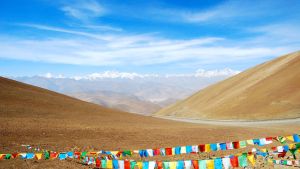
Manufactured Modernity: Dwelling, Labour, and Enclosure in China’s Poverty Resettlements
I first encountered resettled farmers in 2005 to the west of Hohhot in Inner Mongolia. The resettlement village in which I conducted research was the new home of Han Chinese herders from several natural villages who had been moved down off the mountains and into a consolidated settlement near a major highway. Herding had been banned and the mountains effectively enclosed for environmental protection. While people still travelled back to their old villages to tend ancestral graves, they were now embedded in the dairy economy, raising small numbers of cows and selling the milk to Yili Group—a massive state-owned dairy producer. It was in Inner Mongolia and later in Shanxi province that I learnt about the Chinese practice of resettlement as development: these people were not in the way of a dam or major infrastructure project, they were relocated seemingly for their own benefit and to protect a ‘fragile’ environment. Hundreds of thousands of Han and ethnic Mongolian herders were resettled in this way. Herding was once a highly visible livelihood activity in places like Inner Mongolia and throughout the Loess Plateau. These days, while narrow trails still visibly criss-cross the hillsides, a herder with his or her livestock is a rare sight indeed, largely supplanted by industrial livestock production.
Thirteen years on and I am still conducting research in resettlement villages, nowadays in southern Shaanxi and central Gansu. Much has changed in the way that resettlement projects are managed. Perhaps most notably, the scale has only intensified: 2.4 million people are being resettled this decade in just three prefectures in Shaanxi under the Southern Shaanxi Relocation and Settlement Project (shan nan yimin banqian anzhi gongcheng). A total of nearly 10 million people are being resettled between 2016 and 2020 throughout China’s inland provinces (NDRC 2016). One of the key reasons for this escalation is the central government’s stated goal of eliminating absolute poverty in rural areas by 2020, which has been accompanied by massive commitments of funding and intense pressure on local officials to achieve poverty reduction targets. In what follows, I reflect on specific poverty resettlement projects, and Chinese resettlement practice more broadly, to try to make sense of the intent and impact of such large-scale interventions. Why does China turn to resettlement as a solution to so many of the country’s ills? And what role is resettlement playing in the ongoing transformation of the Chinese countryside?
Dwelling
One of the most visible and calculable changes in the lives of resettled farmers is where and how they dwell. Poverty resettlement projects in southern Shaanxi (see images) attempt to manufacture an entirely new way of living. Formerly living in sprawling homesteads with several built structures in which extended families, animals, machinery, and stored crops resided, resettled farmers now occupy high-rise apartments with precise measurements of 60, 80, or 100 square metres. Nothing grows except ornamental trees and flowers, and the odd indoor plant, and no livestock can be found. Unlike most old farmhouses, these apartments feature kitchens connected to gas cooking and with proper ventilation, as well as indoor bathrooms with showers and flushing toilets. Local officials are rightly pleased to show outsiders through soon-to-be-occupied apartments (for which household contributions are now capped at 10,000 RMB) and models of various sized apartments complete with toy furniture. Compared to the ‘dangerous’ conditions in the village, here people can live in a modern, clean, and safe way.
On one level this all makes perfect sense. The condition of housing in poorer villages is often hazardous, particularly to women cooking inside with firewood. And who, having spent any time in a Chinese village, can decry an indoor toilet? But as critical scholars, it is our role to pose additional questions. Why is it that people have to move to enjoy these benefits? Why is it not possible for such ‘development’ to take place in villages? What has changed such that some villages are suddenly considered uninhabitable and some environments fragile? And if people must be moved because of natural disasters or poor infrastructure, why are they not reallocated farmland or given any space to grow vegetables or raise animals?
That the nature of dwelling is so abruptly transformed points to the various motivations and networks of interests that underpin poverty resettlement projects. First, for reasons of food security, land use in China is circumscribed to the point where any loss of farmland to urban or industrial development must be compensated by an equal conversion of land somewhere else into farmland. This quota system means that sprawling rural residences (zhai jidi) are suddenly of great interest to local officials. By relocating farmers to high-rise apartments, demolishing homesteads, and converting this residential land to farmland, a land quota is freed up allowing for urbanisation somewhere more profitable.
Second, under intense pressure to meet the 2020 poverty target, local officials, and the evaluation system within which they are embedded, lean towards visible, quantifiable changes in people’s lives. Relocating a poor household from an old farmhouse to a modern apartment fits the bill perfectly: once relocated, with an asset and a new job (see below) you are no longer poor. Third, resettlement drives a construction boom from which local governments, state-owned enterprises, private firms, and local labourers all reap the benefits. It is difficult to make sense of the proliferation of high-rise resettlement communities without reference to these intersecting motives.
Labour
Resettlement can also transform the nature and place of people’s labour. While earlier resettlement projects like the ones in Inner Mongolia seemed more about agricultural intensification and embedding smallholders within domestic and international supply chains, the imperative to alleviate poverty is now driving a focus on off-farm wage labour. To paraphrase local officials: resettlement allows people to have a ‘stable’ life with a salaried job.
Back in the old villages, farmland is often transferred to cooperatives or agribusinesses, where some resettled farmers might return to work seasonally or simply receive an annual dividend as shareholders. The new settlements, however, often lie alongside purpose-built industrial parks, tourism sites, or agricultural processing facilities, where poor people are prioritised for low-skilled jobs that guarantee a wage of at least 1,500 RMB a month. Such ‘public welfare’ positions also include jobs as gardeners, cleaners, and security guards in the new communities, and are aimed at guaranteeing that at least one person in a poor household has a salaried job and is developing new skills. Given income is so critical to how China measures poverty, these subsidised positions are used as evidence of ‘shedding’ poverty.
One way of interpreting poverty resettlement, therefore, is that it is designed to bring a low-cost labour force into close proximity with capitalist enterprises, many of which are incentivised to move inland by rising wages in wealthier provinces, but also through the use of sweeteners offered by local governments. Farmland is not necessarily fully appropriated, though, and can only be used in certain ways, which means that poverty resettlement—following Julia Chuang (2015)—might lie somewhere between David Harvey’s accumulation by dispossession and Giovanni Arrighi’s accumulation without dispossession. Resettlement certainly dovetails neatly with the central government’s stated preference for larger-scale farms run by ‘new agricultural operators’ (xinxing nongye jingying zhuti)—i.e. anyone but smallholders.
To better understand the impact of these structural forces, we might also examine labour in terms of work practices, or what Ingold (2000) calls the ‘taskscape’. While rural household livelihoods have long been composed of both agricultural work and off-farm labour, resettlement is an attempt to accelerate a shift from the rhythms, tasks, and places of agricultural production and subsistence to those of wage labour and consumption. I say attempt, because in reality things are of course much messier.
In the new industrial parks, some older men and women spend their days indoors on repetitive low-skilled tasks, while younger men might earn slightly more doing higher-skilled metalwork. Those working in walnut or dried tofu processing factories must undergo training to ensure they behave in the necessary way and abide by sanitary regulations. Wages are used to purchase not just the basics, but also the food that is no longer grown. However, given the low pay on offer locally, most young people continue to work in larger cities or in far-flung provinces. Some young women stay behind in the new apartments to care for children and the elderly (see Jacka’s essay in the current issue). Others completely reject these new rhythms and in doing so complicate the clean rural/urban break envisaged by authorities. It is typically the elderly who choose to stay in their village homes and continue the labour of growing vegetables, tending fruit trees, and raising livestock, leaving their allocated apartments to the next generation. Furthermore, resettled people’s household registration (hukou) is not transferred, meaning their medical insurance, pensions, and voting rights are still tied to the village. For some time to come, therefore, there will be continued movement between these places as people negotiate new or modified patterns of work, care, and citizenship.
Enclosure
If, as one resettled farmer described, almost all families have people who have stayed behind in the original villages, then extensive poverty resettlement in China’s mountainous areas might not so dramatically cleave the urban from the rural. However, there is little doubt that the various interests that are tied up in this latest resettlement campaign are seeking to fundamentally remake rural localities.
Poverty resettlement is often linked to poor environmental conditions. Farmers must be resettled because the landscape is ‘unsafe’, suddenly incapable of supporting livelihoods, or because they now reside in a designated water conservancy or biodiversity zone. Entry into some of these areas is now prohibited. Poverty resettlement is also linked to extensive land transfers to agribusinesses. If land usage rights are transferred and farmers receive rent or dividends, then it kills two birds with one stone: poor households have a new income stream, and the way is smoothed for larger-scale operators. People’s reluctance to let go of their old homesteads is the one major sticking point: local officials are now asking people to sign agreements that the old structures will be demolished within three years with the promise of a subsidy. With the farmhouses gone, large-scale operators making decisions about land use, an influx of urbanites enjoying some country respite, and only seasonal farm labour available for former residents, the Chinese countryside will have been remade.
The nostalgia of outsiders would be unhelpful here. After all, China’s mountainous villages can be places of deprivation, illness, toxicity, sexism, and gruelling labour. But that does not preclude a diagnosis that through enclosure, resettlement is an attempt to erase what came before. A dwelling perspective posits that a landscape ‘is constituted as an enduring record of—and testimony to—the lives and works of past generations who have dwelt within it, and in so doing, have left there something of themselves’ (Ingold 2000, 188). From such a perspective, while poverty resettlement projects may seek to (yet again) remake human-environment relations in rural China, the practices, memories, and stories of the landscape cannot be so easily expunged.
Cover Photo: New resettlement communities in Southern Shaanxi (Sarah Rogers).
Bibliography
Chuang, Julia. 2015. “Urbanization Through Dispossession: Survival and Stratification in China’s New Townships.” Journal of Peasant Studies 42, no. 2: 275–94.
Ingold, Tim. 2011. The Perception of the Environment: Essays on Livelihood, Dwelling and Skill. London: Routledge.
National Development and Reform Commission. 2016. “Quanguo ‘shisanwu’ yi di fupin banqian guihua [National ‘13th Five’ Year Plan Poverty Resettlement Plan].” http://www.ndrc.gov.cn/zcfb/zcfbtz/201610/t20161031_824886.html.





